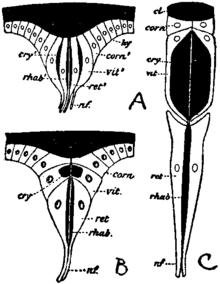Pancrustacea
Parts of this article (those related to documentation) need to be updated. (June 2022) |
| Pancrustacea Temporal range:
| |
|---|---|

| |
| Sally Lightfoot crab (Grapsus grapsus). | |

| |
| Fruit fly (Drosophila melanogaster). | |
| Scientific classification | |
| Domain: | Eukaryota |
| Kingdom: | Animalia |
| Phylum: | Arthropoda |
| Clade: | Pancrustacea Zrzavý & Štys, 1997 |
| Superclasses[1] and extinct orders | |
| |
| Synonyms | |
|
Tetraconata Dohle, 2001 | |

Pancrustacea is the
Molecular studies
A
The evidence for this clade derives from molecular data and morphological characteristics. The molecular data consists of comparisons of
Regier et al. (2005)
In a 2005 study of nuclear genomes Regier et al. suggest that
| |||||||||
| Cladogram following Regier et al. (2005).[6] |
Regier et al. (2010)
A 2010 study of nuclear genomes (Regier et al.) strongly supports Pancrustacea and strongly favour
New clades proposed by Regier et al. are:
- Vericrustacea ("true crustaceans") — Branchiopoda, Copepoda, Malacostraca, Thecostraca;
- Multicrustacea ("numerous crustaceans") — Copepoda, Malacostraca, Thecostraca;
- Communostraca ("common shelled ones") — Malacostraca, Thecostraca;
- Miracrustacea ("surprising crustaceans") — Cephalocarida, Remipedia, Hexapoda;
- Xenocarida ("strange shrimp") — Cephalocarida, Remipedia.
Of these proposed clades, only Multicrustacea was confirmed in later molecular studies.
| |||||||||||||||||||||||||||||||||||||||||||||||||||
| Cladogram following Regier et al. (2010).[7] |
von Reumont et al. (2012)
In a 2012 molecular study, von Reumont et al. challenge the monophyly of Vericrustacea: they present four versions of Pancrustacea cladogram (figures 1–4), and in all four figures
Jondeung et al. (2012)
Another molecular study (of mitochondrial genomes), conducted in 2012 by Jondeung et al., strongly support monophyletic Pancrustacea and places
Oakley et al. (2013)
In 2013 combined study of morphology, including fossils, and molecular data, including expressed sequence tag, mitochondrial genome, nuclear genome, and ribosomal DNA data Oakley et al. obtained support for three pancrustacean clades: Oligostraca (Ostracoda, Mystacocarida, Branchiura, Pentastomida), Multicrustacea (Copepoda, Thecostraca, Malacostraca) and a clade they refer to as Allotriocarida (Branchiopoda, Cephalocarida, Remipedia, Hexapoda), as well as for monophyly of Ostracoda. Within Multicrustacea they obtained support for a clade they suggest the name Hexanauplia: Thecostraca + Copepoda. Relations within Allotriocarida remain uncertain: sister taxon to Hexapoda is either Remipedia, or the clade Branchiopoda + Cephalocarida, however, authors are inclined to the first version (see "Conclusion", 4), which is also consistent with von Reumont et al. (2012) results.[15][13]
New proposed by Oakley et al. clades are:
- Hexanauplia (refers to six ("hexa-") ;
- Allotriocarida ("allotrios" is "strange", "carida" is "shrimp") — Cephalocarida, Branchiopoda, Remipedia, Hexapoda.[15]
Note: the Allotriocarida clade was also recovered in 2005 by Regier et al. as Clade #33,[6] but relations within it were different, and they did not choose a name for it.
| ||||||||||||||||||||||||||||||||||||||||||
| Cladogram following Oakley et al. (2013)[15] |
Rota-Stabelli et al. (2013)
In 2013 Rota-Stabelli et al. used the signal in the 62 protein-coding genes assembled by Regier et al. in 2010 to improve the knowledge of the internal relationship in the Pancrustacea group. This data set infers a highly supported
The following image shows the tree resulting from the Dayhoff recoding.
| |||||||||||||||||||||||||||||||||||||||||||
Lozano-Fernandez et al. (2019)
The relationship of Hexapoda and the crustacean classes is shown in the following phylogenetic tree, which shows Allotriocarida, along with Oligostraca and Multicrustacea, as the three main divisions of subphylum Pancrustacea, embracing the traditional crustaceans and the hexapods (including insects).[1]
| Pancrustacea |
| ||||||||||||||||||||||||||||||||||||
Position of Tantulocarida
According to Petrunina A.S. and Kolbasov G.A., the sixth subclass of Maxillopoda
| |||||||||||||||||||||
| Thecostraca cladogram following Petrunina (2012), page 19, picture 8[18] |
See also
References
- ^ PMID 31270537.
- .
- PMID 20624745. Archived from the originalon 2012-07-10.
- Annales de la Société Entomologique de France. 37 (1–2): 85–103.
- (PDF) from the original on 2016-06-02.
- ^ PMID 15734694.
- ^ S2CID 4427443.
- (PDF) from the original on 2023-09-11.
- S2CID 84370269.
- S2CID 38792657.
- .
- S2CID 4397099.
- ^ PMID 22049065.
- S2CID 254830063.
- ^ PMID 22977117.
- (PDF) from the original on 2021-02-25.
- ^ Петрунина А.С., Колбасов Г.А. (2011). "Two species of Tantulocarida from the White Sea: what new could they tell us about morphology, anatomy and phylogeny of these minute parasitic crustaceans?" (in Russian). 11th International Conference on Copepoda. Archived from the original on 2023-11-26.
- ^ a b Петрунина Александра Сергеевна (2012). "Микроскопические ракообразные класса Tantulocarida: морфология, анатомия, систематика и филогения [Microscopic crustaceans of the class Tantulocarida: Morphology, anatomy, systematic and phylogeny]" (PDF) (in Russian). Archived from the original (PDF) on April 17, 2019.
